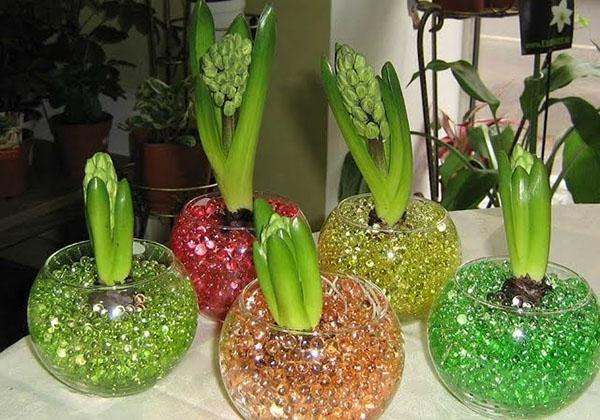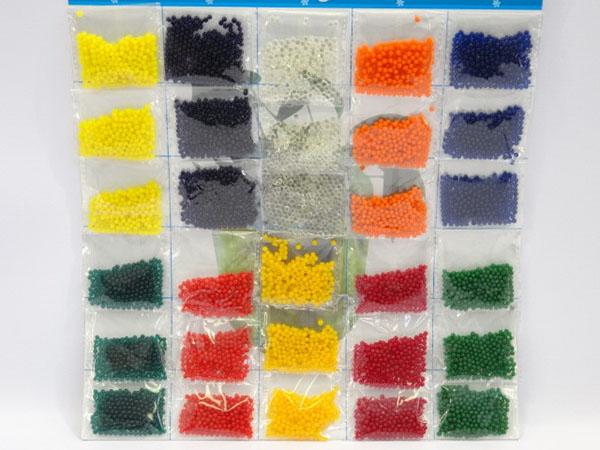We buy and use a hydrogel for plants
 For growing seedlings and indoor flowers, a hydrogel for plants is widely used. It is used in combination with soil, or in pure form. Due to its structure, the substance absorbs moisture, protecting the roots from drying out and waterlogging. For proper use, you need to study the instructions for use, consider the pros and cons.
For growing seedlings and indoor flowers, a hydrogel for plants is widely used. It is used in combination with soil, or in pure form. Due to its structure, the substance absorbs moisture, protecting the roots from drying out and waterlogging. For proper use, you need to study the instructions for use, consider the pros and cons.
Hydrogel properties

A hydrogel is a polymeric substance in granular or powder form. It is characterized by the following qualities:
- the hydrogel formula retains moisture and applied top dressing;
- positively affects the structure of the soil;
- prevents the appearance of cracks on the soil surface;
- promotes abundant flowering and fruiting.
- long term (about 5 years).
 Interacting with water, the hydrogel swells and increases in volume several times. The finished substance should be mixed with the soil and the plant should be planted in the substrate. Upon germination, the root system will be hydrated without additional watering for 15-20 days. The thicker the roots, the longer it won't need watering. After watering, the balls grow again without losing their functionality.
Interacting with water, the hydrogel swells and increases in volume several times. The finished substance should be mixed with the soil and the plant should be planted in the substrate. Upon germination, the root system will be hydrated without additional watering for 15-20 days. The thicker the roots, the longer it won't need watering. After watering, the balls grow again without losing their functionality.
Varieties and composition of hydrogel for plants
There are two types of plant hydrogel:
- Soft. It is used for planting indoor plants, germinating seeds and planting garden crops. Thanks to the softness of the granules, it is ideal for vegetation with a delicate root system. The roots grow inside the balls and are saturated with moisture.

- Dense (aqua soil). Its characteristic feature is multicolored or shiny granules. Used as a decoration for flower pots.

Aqua soil is not suitable for growing flowers. It can only be used for decorative purposes, for example, for bouquets placed in a transparent vase.
These types of hydrogels are widely used by flower growers and designers, as they have many advantages over conventional soil.
Composition
 The chemical composition of the hydrogel for plants does not contain toxic elements and is completely safe for human and plant health. After the end of their operational life, the components disintegrate and turn into organic substances.
The chemical composition of the hydrogel for plants does not contain toxic elements and is completely safe for human and plant health. After the end of their operational life, the components disintegrate and turn into organic substances.
Advantages and disadvantages

The positive qualities of a hydrogel for plants include:
- shortening the germination time and increasing the yield;
- pre-soaking the balls in the fertilizer provides the plant with nutrients for a long time;
- the soil becomes loose and saturated with oxygen;
- when mixed with open ground, the probability of survival of seedlings increases;
- the use of a hydrogel when planting a decorative lawn, will preserve the greenery until late autumn;
- 1 liter of soil requires only 1.5 g of dry powder.
The substance has few disadvantages:
- the composition of the hydrogel is not suitable for the germination of legumes and sweet peas;
- prolonged exposure to the sun can lead to mold;
- if used in pure form, it should be changed every two years.
To make sure of the effectiveness of the granules, it is worth applying it on your own site or house plants.
Terms of use
Before using the hydrogel in the garden or for planting indoor flowers, it is worth giving it time to swell by placing it in a spacious open container.If the balls are added dry, when they swell, they can push the plant to the surface.
Growing greens
 Greens contain many trace elements, so eating every day has a positive effect on the body. Fine fraction Stockosorb hydrogel makes it possible to create mini-vegetable garden on the windowsill.
Greens contain many trace elements, so eating every day has a positive effect on the body. Fine fraction Stockosorb hydrogel makes it possible to create mini-vegetable garden on the windowsill.
This will require:
- Pour the substance into a large container and add water for several hours.
- After swelling, remove excess water by discarding in a colander.
- Distribute material to planting pots.
- Spread dry seed on the surface without deepening.
- After waiting for a suitable seedling size, harvest the crop.
 After that, you can replant the vegetation in the container.
After that, you can replant the vegetation in the container.
Flower transplant
 The instructions for use of the hydrogel involve pre-soaking before adding it to the flower.
The instructions for use of the hydrogel involve pre-soaking before adding it to the flower.
A step-by-step guide to action consists of the following points:
- remove the plant from the container along with the earthy clod;
- remove excess soil without damaging the root system;
- rinse the roots under running water;
- pour drainage and some soil into a new container;
- put a flower in pot, spread the roots;
- fill the pot to the brim with soil mixed with the hydrogel.
 After completing the transplanting operations, spray the surface with water, and then do not water for the next 10 days.
After completing the transplanting operations, spray the surface with water, and then do not water for the next 10 days.
Gardening and horticulture
 In horticulture, balls are used in dry form for grafting shrubs, rooting, transplanting seedlings in a ratio of 1 to 5. With the help of this substance, the soil is saturated with nutrients, loosening of dense soil and an increase in oxygen access. The pellets can be dug around the trunks of already mature trees and bushes.
In horticulture, balls are used in dry form for grafting shrubs, rooting, transplanting seedlings in a ratio of 1 to 5. With the help of this substance, the soil is saturated with nutrients, loosening of dense soil and an increase in oxygen access. The pellets can be dug around the trunks of already mature trees and bushes.
You should also figure out what a hydrogel for a garden is and how to use it correctly. It is ideal for germinating seeds, growing seedlings outdoors until the beginning of flowering.
Granules saturated with top dressing will increase the fruiting of plants, protect them from diseases and are suitable for the following crops:
- cabbage;
- tomatoes;
- cucumbers;
- potatoes;
- radish.
Before planting plants, it is necessary to place the balls into the soil to a depth of 5 cm at the rate of 20 g of dry matter per 1 sq. m.
When using a hydrogel, it is important not to flood the plant, so watering the soil should be no more than once every two weeks.
Precautions and features of use

So that the substance does not lose its original qualities, it is necessary to adhere to certain recommendations:
- Do not allow exposure to direct sunlight on the substance. As a result, microscopic algae may appear inside the balls.
- Water the plant in pots once every 14 days, immediately removing excess water from the pan.
- Before using the hydrogel for indoor flowers, it must be allowed to swell. Do not pour dry matter into a closed container.
- For large flowers, it is worth using a limited amount of substance. Otherwise, without support, the plant may fall.
- When using pure hydrogel, the planting container should be transparent;
- Before diluting the hydrogel, it is necessary to prepare settled or distilled water.
- Planting seeds for seedlings should be done in a pre-crushed gel.
- Watering should be carried out five times less often than in the presence of land. The lack of moisture leads to the sedimentation of the substance, therefore the lack of water is visible to the naked eye.
Having figured out what a hydrogel is for, you can use it to grow various varieties indoor plants and decorating flower arrangements. Before planting, it is worth remembering that aqua soil cannot be used for long-term planting. For these purposes, white hydrogel granules are used.